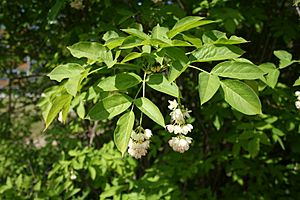European bladdernut facts for kids
Quick facts for kids European bladdernut |
|
|---|---|
 |
|
| Scientific classification |
The Staphylea pinnata, also known as the European bladdernut, is a cool type of bladdernut plant. It grows naturally in Europe and has also started growing on its own in Britain.
What is the European Bladdernut?
This plant is a deciduous shrub, which means it's a woody plant that loses its leaves every autumn. It can grow quite tall, up to about 20 feet high! Its scientific name, pinnata, describes its leaves. These leaves are pinnate, meaning they have leaflets arranged on either side of a central stem, kind of like a feather.
Flowers and Fruit
In late spring and early summer (May to June), the European bladdernut shows off its small, white, bell-shaped flowers. They smell nice and grow in clusters called panicles, which can be up to 5 inches long. These flowers are special because they are bisexual. This means each flower has both male and female parts. Tiny flies help to pollinate these flowers, helping them make seeds.
Later in the year, from September to November, the plant grows interesting fruits. These fruits are like puffy, papery balloons, often with two or three sections, and can be up to 1.5 inches long. Inside these "bladders" are the seeds. Guess what? These seeds are safe to eat! People say they taste a bit like pistachios.
Growing European Bladdernut
You can grow the Staphylea pinnata in places that get lots of sun or a little bit of shade. It's not too picky about the soil it grows in, so it can handle different types. This plant is considered quite tough and can survive cold winters in certain zones (like zones 6–8). However, it doesn't like very dry conditions, so it needs enough water to stay healthy.

